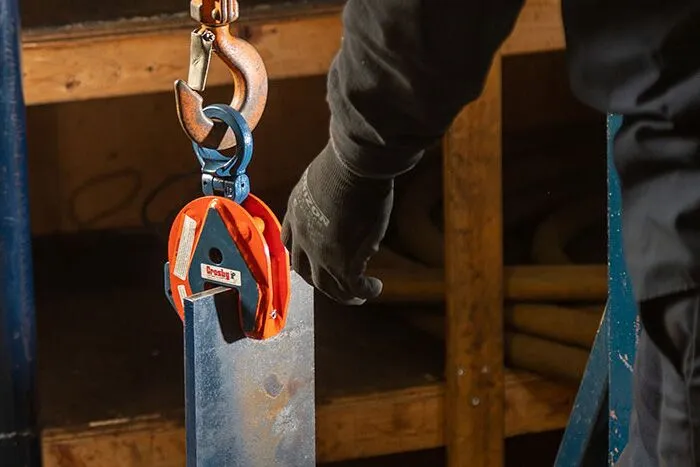Plate Clamp Service
Hercules SLR Plate Clamp Service: Inspection, Test, Maintenance, And Certification
Plate clamp inspection: Canadian law states that plate cla mps must be inspected and certified every year by a qualified professional.
mps must be inspected and certified every year by a qualified professional.
Hercules SLR provides ASME certified inspection, testing, and certification services for plate clamps.
Plate clamp safety standards are laid out in ASME B30.20, along with standards for other below-the-hook lifting devices.
The ASME certified plate clamp service experts at Hercules SLR can thoroughly inspect, test, and certify plate clamps. Bring them to one of our shops across Canada or have our trained service professionals come to you.
Contact Canada’s plate clamp inspection, testing, certification, and repair experts at Hercules SLR today.
Plate Clamp Inspection, Care & Maintenance

Frequently Asked Questions
What are plate clamps?
– Lifting clamps are used to lift, hoist, and transfer items like plates, sheets, grinders, pipes, and other materials. Lifting clamps employ powerful springs that allow the clamp to become one with the material being clamped. Lifting clamps are most used on sheets, plates, or fabrications; as a result, many people refer to them as ‘plate clamps’ or ‘sheet clamps
What to look for when inspecting a plate clamp before using it?
– Loose bolts or fasteners
– Cracked or worn gears, pulleys, sheaves, sprockets, bearings, chains, and belts
– Structural deformation, cracks, excessive wear, or bends
– Loose or missing guards, stops, or name plates
– Excessive wear of friction pads, linkages, and other mechanical parts
– Excessive wear at hoist hooking points and load support clevises or pins
– Missing or illegible product safety labels
How often a plate clamp be inspected?
– Initial Inspections: Before use (new, altered, modified, or repaired)
– Frequent Inspections: each day or shift before the sling is used
– Periodic Inspections:
-Normal service – yearly
-Severe service – monthly
-Special service – as recommended by a qualified person
Examples of daily checks a user can do when using plate clamp?
– Always follow the hardware’s manufacturer maintenance recommendations.
– Inspect internal and external surfaces for forging or weld fractures, wear, or distortion.
– Check all pin holes for wear.
– Inspect the throat (clamp opening) width – At zero grip, the clamp should be in full contact with the pad.
Measure the width of the throat – If the measurement at the base (where the pad is located) is greater than at the top, the body has been overloaded and the clamp and tag need to be replaced.
Where to get a plate clamp serviced?
– Customers can come to one of our shops across the country or we can come to you with our Mobile Testing Unit. Technicians at Hercules SLR are trained and certified with LEEA accreditation. All inspections are completed within ASME standards.
What to Avoid When Using Plate Clamps?
– Do not lift over workers.
– Do not stand near a load.
– Position yourself away from and fully clear of the load. Remember to also consider howthe load might fall when it lands.
– Do not overload or under-load a clamp.
– Do not lift from the side with a vertical clamp.
– Do not lift more than one plate at a time with a vertical clamp.
– Do not lift plate from the bottom of a plate stack.
– Do not drag the load using the plate clamp.
– Do not grind, weld or modify a clamp.
– Do not use a clamp having a minimum jaw opening larger than the thickness of the load.
– Do not leave suspended loads unattended.
Plate Clamp Inspection, Certification and use
How to Use Plate Clamps Safely
– Select the correct plate clamp for the job. There are clamps for vertical, horizontal or universal (multi-directional) lifting. Clamps are also rated for the thickness of the plate they are designed to lift
– Refer to the manufacturers’ operating instructions
– Plate clamp Inspect visually before each lift
– Lift one plate at a time unless using clamps and methods approved otherwise
– Use two or more clamps to balance a long or flexible load
– Install the clamp (or clamps) over the centre of gravity of the plate.
– When using a vertical type of plate clamp, use a locking device to prevent accident loosening
– Use horizontal types of plate clamps in pairs.
– Use clamps within their rated capacity and flange width.
– Lock a clamp closed before lifting a load.
– Use a sling between the clamp and the crane or hoist hook.
– Use non-marring (rubber pad) clamps in pairs when lifting finished and polished plates
– Lift smoothly; avoid jolts
– If the use of a tag line is necessary, attach it to the clamp before lifting the plate
How to Inspect the Exterior of a Plate Clamp
– Follow the clamp manufacturers’ maintenance recommendations
– Inspect internal and external surfaces for forging or weld fractures, wear and distortion
– Check all pin holes for wear
– Inspect the throat (clamp opening) width. At zero grip, the cam should be in full contact with the pad
– Measure the width of the throat. If the measurement at the base, where the pad is located is greater than at the top, the body has been overloaded. Replace the clamp and tag the defective clamp and remove it from servic

